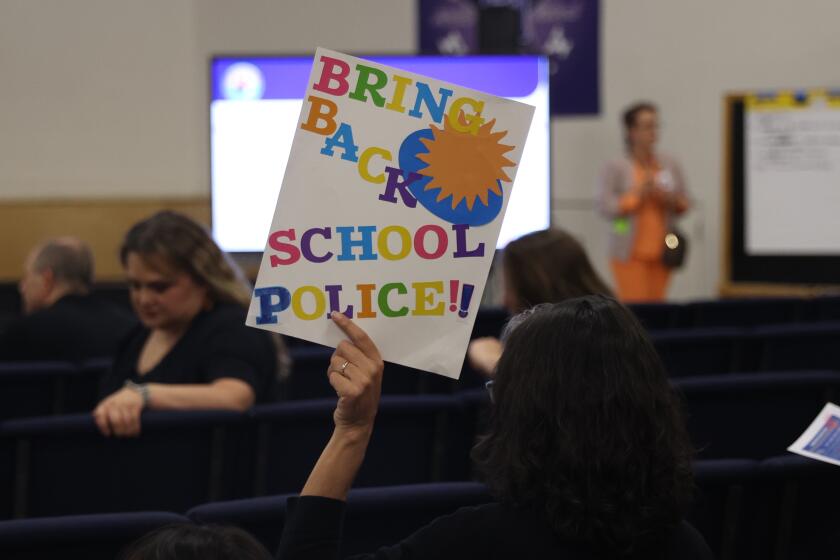Education Dept. Shifts, Favors Bilingualism
The Education Department, reversing its previous opposition to expanded bilingual education, is quietly shifting federal policy in favor of programs that teach students English as well as other subjects using their native languages.
“It’s a very significant shift,” said James Lyons, executive director of the National Assn. for Bilingual Education. The department’s new posture contrasts sharply with the policies of former Education Secretary William J. Bennett, who “tried to obliterate the native language skills of children,” according to Lyons.
Authorities said one of the most important signs of change was Education Secretary Lauro F. Cavazos’ selection of Rita Esquivel, former assistant superintendent at the Santa Monica-Malibu Unified School District, to head the department’s bilingual education program.
Under Cavazos and Esquivel, the department is “becoming more aware of the positive results that use of native language instruction can have on children in bilingual education,” said Denise de la Rosa of the National Council of La Raza, a Latino lobbying organization.
The change in the Education Department under Cavazos is “very radical, like night and day,” said Shelly Spiegel-Coleman, a consultant to the Los Angeles County Department of Education and former president of the California Assn. of Bilingual Education.
California schools currently have 742,559 students with limited English skills, most of whom speak Spanish, according to unpublished figures recently compiled by the state Department of Education. That represents a 14% jump over last year’s figure, compared to normal annual increases of 6% to 8%.
About 16% of Orange County’s 350,000 public school students are considered limited in English, and the figure continues to grow as the influx of immigrants from Mexico, Central and Latin America, Southeast Asia and other areas around the globe continues.
While the shift in the Administration’s policies are noticeable, Santa Ana Unified School District Assistant Supt. Anthony Dalessi said it has not meant any changes in his own district, the county’s largest, and which has the largest percentage of limited-English students. They make up 51% of the district’s 40,000 students.
Dalessi said Santa Ana Unified for some time has supported the idea that children limited in English learn better by instruction in their own language, rather than through the immersion method, which some educators have referred to as the “sink or swim” approach.
“There are a preponderance of studies that show kids end up better academically in junior and senior high school if they are in a bilingual program rather than an immersion program,” he said.
But Gloria Tuchman, a longtime critic of bilingual education who is a trustee in the Tustin Unified School District and a teacher in Santa Ana Unified, is discouraged by the Administration’s change in direction.
“In my opinion, it’s a lot of brainwashing to say that transitional bilingual education is the only method,” said Tuchman, referring to programs that emphasize a student’s native language. “I totally object to one philosophy being dictated to us.
“We have a severe shortage of bilingual teachers, and it makes it almost impossible to carry out these plans,” said Tuchman, who was appointed by Bennett in 1987 to serve on the National Advisory Council for Bilingual Education.
When Cavazos announced Esquivel’s appointment at the May convention of the National Assn. of Bilingual Education, he voiced his opposition to placing children with limited English skills into all-English classrooms. “The sink-or-swim days of learning English are over, and they must never be allowed to come back,” he declared.
“At the same time that we are teaching our children English, we must do all we can to help them maintain their native language and culture,” Cavazos told the educators. “Those are treasures which we should not waste.”
In an interview last week, Esquivel did not characterize the department’s policies as having changed significantly since she assumed office July 1.
“The primary purpose (of bilingual education) has always been the same, but probably my style is a little different,” she said.
“Our goal . . . is to travel throughout the country and to tell people that the primary goal of bilingual education is to teach children English, and that there are many ways of teaching children English,” Esquivel said in an interview.
“Our agenda is that we want to be very open and inclusive of everyone, and our agenda is that we will use the primary language where cases are possible . . . keeping in mind that it’s only to build a bridge to learning English,” she said.
Former Education Secretary William J. Bennett blasted bilingual education as ineffective and asked that more federal funds be directed toward programs that teach classes in English rather than the students’ native language.
“Bennett wanted to eliminate programs,” said de la Rosa. “There was less funding of programs that were truely bilingual, and money was funneled into English-only programs.”
Even so, de la Rosa she said she would not be certain that a policy shift had occurred until the department allocates more funds to grants for schools with bilingual education programs using students’ native languages. The first budget prepared by Esquivel will not take effect until the 1991 school year.
The department provides grants to school districts for three main types of bilingual programs: transitional programs in which students are taught math and other basic skills in their native languages while they are learning English; sheltered English programs in which children are taught in English geared to their level of comprehension; and immersion programs in which children are left to compete with their English-speaking peers.
Transitional bilingual education has drawn fire from Los Angeles-based LEAD (Learning English Advocates Drive) and other English-first groups. They argue that students in bilingual programs rely too heavily on their native languages and do not learn English quickly.
“There’s so much evidence for bilingual education and so many problems with immersion that we’re really glad that Washington supports this view,” said Sandra Andersen, executive director of the California Assn. of Bilingual Education. “We can get programs funded that we know will work.”
Officially, the Education Department does not favor one teaching method over another, Esquivel said. But she noted that she is “very much in favor of transitional bilingual education,” and other programs, depending on the needs of the district.
“My philosophy is that there has to be local control,” she said. “The people of the community need to decide what is best for their school.”
In addition to working as an administrator in the Santa Monica-Malibu school system, Esquivel has taught elementary and secondary school for nearly 30 years--an experience she acknowledged affected her views of bilingual education.
“When I taught in schools where all the children spoke Spanish, a lot of them were not able to keep up, a lot got discouraged and dropped out. We used to punish children for speaking Spanish on the playground,” she said.
“Children lost their self-esteem. They felt that what was spoken at home by their parents was something that was not good.”
Esquivel’s sensitivity toward children with limited English skills, coupled with her expertise in bilingual programs, drew praise from bilingual advocates, who said they were pleased they would no longer have to battle the department.
“She knows first-hand what it means for a student to work in his primary language,” said Spiegel-Coleman, the Los Angeles consultant.
Times staff writer Maria Newman in Orange County contributed to this story.
More to Read
Start your day right
Sign up for Essential California for news, features and recommendations from the L.A. Times and beyond in your inbox six days a week.
You may occasionally receive promotional content from the Los Angeles Times.






